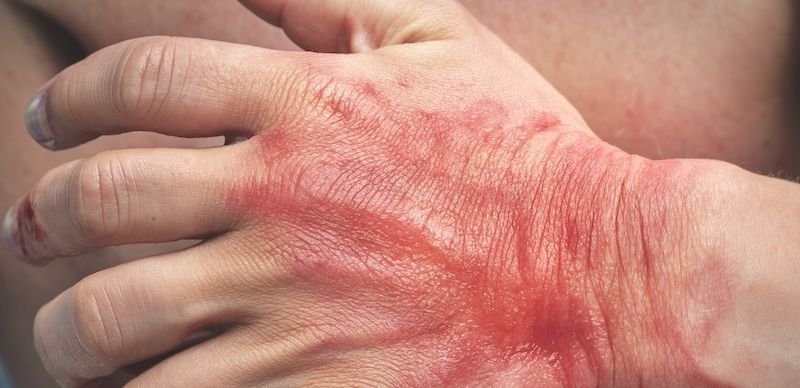Nickel allergy is becoming more widespread, even among children. From allergic contact dermatitis to systemic allergic reactions, nickel allergy can make the lives of those allergic to it unbearable. We present to you another 100 thingies worth knowing; Nickel Allergy! How much do you know about nickel allergy? Here are 100 facts about Nickel allergy worth knowing, especially for those allergic to it.
1. Nickel Allergy Is One of the Most Common Causes of Allergic Contact Dermatitis

Nickel allergy affects up to 20% of the population, making it one of the most prevalent forms of contact dermatitis.
2. It’s More Common in Women Than Men
Studies suggest that nickel allergy is more prevalent among women, largely due to greater exposure to nickel-containing jewelry.
3. The Allergy Develops Through Skin Contact
Nickel allergy develops after prolonged exposure to items containing nickel, leading the immune system to react to nickel as a harmful substance.
4. Earrings Are a Common Source of Sensitization
Many people develop a nickel allergy after getting their ears pierced with nickel-containing earrings, making this a common sensitization source.
5. The Allergy Can Develop at Any Age
Although often developing in childhood or young adulthood, nickel allergy can start at any age, depending on exposure.
6. Nickel Can Be Found in Many Everyday Items
Besides jewelry, nickel is present in coins, zippers, eyeglass frames, cell phones, and even some food items.
7. Reactions Can Vary in Severity
Symptoms range from mild redness and itching to severe rashes and blistering at the contact site.
8. Dietary Nickel Can Affect Those Severely Allergic
In rare cases, individuals highly sensitive to nickel may react to foods high in nickel, such as nuts, chocolate, and certain grains.
9. Nickel Allergy Is Diagnosed With a Patch Test
Dermatologists use patch testing, applying small amounts of nickel to the skin to observe for reactions, as a diagnostic tool.
10. There is an App to Check Nickel Content of Tested Food Items

In case you didn’t know, there’s an APP for checking the nickel content of analyzed and nickel-tested food items such as oats, various vegetables, fruits, etc. Check out Rebelytics’ Nickel Navigator App.
11. Nickel Release Can Be Accelerated by Sweat
Sweating can cause nickel in metal items to dissolve faster, increasing the likelihood of a skin reaction.
12. Some Countries Have Regulations Limiting Nickel Use
The European Union has strict regulations on the amount of nickel that can be released from products intended to come into direct and prolonged contact with the skin.
13. Smartphone and Tablet Cases Can Contain Nickel
Some cases and accessories for electronic devices may contain nickel, potentially causing reactions in sensitive individuals.
14. Clothing Fasteners Are Common Culprits
Nickel is often used in buttons, snaps, and zippers, which can lead to reactions where clothing fits tightly against the skin.
15. Nickel-Free Labels May Not Always Be Accurate
Products labeled “nickel-free” may still contain trace amounts of nickel, enough to trigger a reaction in highly sensitive individuals.
16. Dental Braces Can Contain Nickel
Orthodontic braces often contain nickel, which can cause localized reactions in the mouth for those with an allergy.
17. Reactions May Be Mistaken for Infections
Nickel allergy symptoms can sometimes resemble infections, leading to misdiagnosis and incorrect treatment.
18. Jewelry Can Be Coated to Reduce Exposure
Nickel-containing jewelry can be coated with a layer of nickel-free metal or clear nail polish to minimize skin exposure.
19. Leather Can Harbor Nickel
Nickel can be found in tanning agents used in processing leather, posing a risk for those with allergies.
20. Keys Are Often Nickel-Plated

Many keys are made from nickel-plated brass, which can cause allergic reactions upon prolonged handling.
21. Work-Related Exposure Is Common in Certain Industries
Individuals working in metalworking, hairdressing, and construction may have increased exposure to nickel, raising the risk of developing an allergy.
22. Children Can Inherit a Predisposition to Nickel Allergy
There is a genetic component to nickel allergy, with children of allergic parents being more likely to develop the condition.
23. Makeup and Personal Care Products May Contain Nickel
Trace amounts of nickel can be found in cosmetics, shampoos, and soaps, contributing to facial dermatitis in sensitive individuals.
24. Handling Coins Can Trigger Symptoms
Frequent handling of coins, which often contain nickel, can lead to hand dermatitis in allergic individuals.
25. Stainless Steel Contains Nickel but Often Doesn’t Cause Reactions
Although stainless steel contains nickel, it’s tightly bound within the alloy, making it less likely to cause reactions in most people with nickel allergy.
26. Tattoos Can Expose Individuals to Nickel
Nickel is present in some tattoo inks, potentially causing localized or widespread dermatitis in allergic individuals.
27. Cooking Utensils May Release Nickel
Nickel-plated or stainless steel cooking utensils can release nickel, especially when used to cook acidic foods.
28. The Severity of Allergic Reactions Can Change Over Time
The severity of allergic reactions to nickel can fluctuate, with some individuals experiencing worsening or improvement of symptoms over time.
29. Nickel Allergy May Coexist With Other Allergies

Individuals with nickel allergy may also be allergic to other metals, such as cobalt allergy and chromium allergy, which are often found together with nickel.
30. Washing Hands Frequently Can Reduce Risk
Frequent hand washing can minimize the risk of transferring nickel from objects to sensitive areas of the skin.
31. Protective Clothing Can Help Avoid Contact
Wearing gloves or other protective clothing can help minimize skin contact with nickel in occupational settings.
32. Avoiding Canned Foods May Benefit Those With Severe Allergies
Nickel can leach into food from cans, so those with severe allergies may benefit from avoiding canned foods.
33. Body Piercings Increase the Risk of Sensitization
Body piercings, particularly when done with nickel-containing jewelry, can increase the risk of developing a nickel allergy.
34. Symptoms Can Appear Hours to Days After Exposure
Symptoms of nickel allergy can take from a few hours to several days after exposure to appear, complicating the identification of the trigger.
35. Climate Can Influence Nickel Allergy Reactions
Humid climates can exacerbate nickel allergy reactions due to increased sweating and moisture on the skin…which promotes the release and absorption of nickel ions into the skin. So, if you can, choose your habitat wisely.
36. Alcohol Can Increase Skin Absorption of Nickel
Alcohol-based products applied to the skin can increase the absorption of nickel, potentially worsening symptoms.
37. Eyeglass Frames Can Be a Source of Exposure
Nickel is commonly used in eyeglass frames and can cause reactions on the bridge of the nose and behind the ears.
38. Testing for Nickel in Products Is Possible
Special test kits are available that can detect the presence of nickel in objects, helping individuals identify potential sources of exposure.
39. Nickel Allergy Can Affect Quality of Life
The need to avoid contact with nickel can impact daily activities and choices, from personal accessories to occupational materials, affecting the quality of life.
40. Awareness and Education Are Key to Management

As there are no known treatments currently, education about potential sources of nickel exposure and strategies for avoidance is crucial for effectively managing nickel allergy and minimizing symptoms.
41. Topical Treatments Can Provide Relief
Topical corticosteroids and emollients can be used to treat skin reactions caused by nickel allergy, providing relief from itching and inflammation.
42. Oral Antihistamines May Reduce Symptoms
For some individuals, oral antihistamines may help reduce itching and discomfort associated with nickel allergy dermatitis.
43. Nickel Allergy Is Not Related to Nickel in Food
Although dietary nickel can affect those with systemic nickel allergy, nickel allergy from skin contact does not correlate with sensitivity to nickel ingested in food for most people.
44. The Nickel Spot Test Can Identify Nickel Release
The dimethylglyoxime (DMG) spot test is a simple method that can detect the release of nickel from objects, helping individuals avoid allergenic exposure.
45. Surgical Implants Containing Nickel Rarely Cause Reactions
Despite concerns, nickel-containing surgical implants (e.g., joint replacements) rarely cause allergic reactions, possibly due to the form and stability of nickel in the alloy.
46. “Hypoallergenic” Does Not Mean Nickel-Free
Products labeled as “hypoallergenic” may still contain nickel, as this term only indicates that the product is less likely to cause allergic reactions, not that it is free of specific allergens.
47. Nickel Content Varies in Foods
Foods such as oats, beans, and certain types of nuts and chocolate have higher nickel content, which may need to be limited in individuals with systemic nickel allergy. The nickel content of particular fruits or vegetables differs in different countries.
48. Dental Nickel Allergy Is Rare but Possible
Nickel is used in some dental appliances, and while rare, individuals with nickel allergy can develop localized oral symptoms.
49. Avoiding Nickel Can Lead to Sensitization Decrease
Some individuals may experience a decrease in nickel sensitization over time with strict avoidance, though this is not guaranteed.
50. There Is Ongoing Research into Nickel Allergy Treatments
Research into treatments for nickel allergy is ongoing, including the development of topical therapies that reduce skin absorption of nickel and other potential interventions.
51. It’s Present in The Soil

Yes, soil contains nickel, and the plants grown on it absorb it, which then gets into our food when we consume these vegetables and fruits.
52. Nickel in Electronic Devices
Many electronics, including laptops and mobile phones, contain nickel. Individuals with a nickel allergy may experience skin reactions from prolonged contact with these devices, underscoring the importance of using covers made from hypoallergenic materials.
53. We Get it From water, Too
Don’t be alarmed now, nickel, though causes lots of sleepless nights, is also crucial to a healthy living so it shouldn’t alarm you that water contains nickel.
54. Nickel Allergy and Seasonal Variations
Seasonal changes can influence the severity of nickel allergy symptoms. For example, symptoms may worsen in summer due to increased sweating, which facilitates the release of nickel ions from metal objects into the skin.
55. The Challenge of Detecting Nickel in Consumer Products
Detecting nickel in consumer products can be challenging, as nickel is often used in alloys and may not be explicitly listed on product labels. This makes it difficult for individuals with nickel allergy to identify potential sources of exposure.
56. False-Negative Results in Patch Testing
While patch testing is the standard method for diagnosing nickel allergy, false-negative results can occur. This may happen if the concentration of nickel used in the test is too low to elicit a reaction or if the individual’s skin is not in a reactive state at the time of testing.
57. The Psychological Impact of Nickel Allergy
Living with nickel allergy can have a psychological impact, causing stress and anxiety related to avoiding exposure and managing symptoms. The constant vigilance required can affect individuals’ social life, work, and overall well-being.
58. Nickel Allergy in Children
Nickel allergy is increasingly being diagnosed in children, partly due to the early use of nickel-containing jewelry and metal fasteners in clothing. Educating parents and caregivers about the risks of early nickel exposure is crucial for prevention.
59. The Use of Barrier Creams
Barrier creams such as this can provide a protective layer on the skin, reducing direct contact with nickel and the risk of allergic reactions. These creams are especially useful for individuals who cannot avoid nickel exposure due to occupational requirements.
60. Nickel Allergy and Cosmetic Products

Nickel can be a contaminant in cosmetic products, including eyeshadows, foundations, and even some lipsticks. Individuals with nickel allergy should look for cosmetics specifically labeled as nickel-free or formulated for sensitive skin.
61. Systemic Nickel Allergy Syndrome (SNAS)
Systemic nickel allergy syndrome (SNAS) is a condition where ingestion of nickel-containing foods leads to systemic symptoms, including skin eruptions, gastrointestinal discomfort, and respiratory issues. Management involves a low-nickel diet, which can be challenging due to the ubiquitous nature of nickel in the environment and food supply.
62. Nickel Allergy and Hand Eczema
Hand eczema is a common manifestation of nickel allergy, particularly in occupations that involve handling nickel-containing materials. Using protective gloves and implementing strict hand hygiene practices can help manage symptoms.
63. Cross-Reactions with Other Metals
Individuals allergic to nickel may also experience cross-reactions with other metals, such as cobalt and palladium, which often coexist with nickel in alloys. Identifying and avoiding these metals is essential for comprehensive management of the allergy.
64. Improvements in Nickel Allergy Management
Advances in dermatological research have led to improved management strategies for nickel allergy, including the development of more effective topical treatments and the increased availability of nickel-free products.
65. Public Awareness and Advocacy
Raising public awareness about nickel allergy and advocating for stricter regulations on nickel use in consumer products are important steps in reducing the prevalence of the allergy and supporting affected individuals.
66. The Economic Cost of Nickel Allergy
Nickel allergy not only affects individuals’ health and quality of life but also has economic implications, including the cost of medical care, allergy testing, and lost productivity due to symptoms and disease management.
67. Nickel Allergy and Piercings
The popularity of body piercings has contributed to the rise in nickel allergy cases. It’s crucial for piercing studios to use nickel-free materials and for individuals to be aware of the potential for sensitization.
68. Differential Diagnoses for Nickel Allergy
Differentiating nickel allergy from other skin conditions, such as psoriasis, atopic dermatitis, and other types of contact dermatitis, is essential for accurate diagnosis and treatment. A comprehensive medical history and targeted testing are critical components of the diagnostic process.
69. Alternative Materials for Nickel Allergy Sufferers
For those with nickel allergy, alternatives to nickel-containing metals include stainless steel, titanium, and plastic for everyday items such as jewelry, watches, and buttons. Awareness of these alternatives can significantly improve daily comfort and reduce allergic reactions.
70. The Role of National and International Standards
The implementation of national and international standards limiting nickel release from consumer products has contributed to a decrease in the incidence of nickel allergy in some regions, highlighting the importance of regulatory measures in public health.
71. Understanding Nickel’s Ubiquity

Nickel’s widespread use in various industries—from fashion to electronics—stems from its durability and resistance to corrosion. For those with nickel allergies, understanding which everyday items typically contain nickel can be the first step in avoiding exposure.
72. Nickel Allergy and Contact with Coins
Handling coins, which often contain nickel, can pose a risk for individuals with severe allergies. While brief contact may not always cause a reaction, awareness and minimizing handling can help prevent symptoms.
73. Prevalence of Nickel Allergy Across Different Populations
Research indicates variability in nickel allergy prevalence across different countries and ethnicities, suggesting that genetic, environmental, and cultural factors may influence susceptibility to the allergy.
74. Impact of Nickel Allergy on Lifestyle Choices
Nickel allergy can significantly impact lifestyle choices, requiring individuals to select jewelry, clothing, and personal care products carefully, or if they’re suffering from SNAS, too, dietary options to avoid allergic reactions.
75. Nickel Allergy and Vaccination Sites
Rarely, nickel allergy can affect vaccination sites if the needles used contain nickel. Though extremely uncommon, using nickel-free medical equipment where possible can mitigate this risk.
76. Advancements in Detection and Testing
Emerging technologies in allergy detection, including more sensitive and specific patch tests and non-invasive testing methods, promise better diagnostics and understanding of nickel allergy.
77. Environmental Nickel and Its Implications
Nickel occurs naturally in the environment, and human activities have increased its presence. For those with severe allergies, understanding environmental nickel sources, such as soil and water, is crucial for comprehensive management.
78. Strategies for Managing Nickel Allergy in the Workplace
Occupational exposure to nickel requires strategic management, including the use of protective barriers, substitution of nickel-containing materials, and employee education to minimize allergic reactions.
79. Nickel Allergy’s Link to Other Skin Conditions
Individuals with nickel allergy may find that their condition exacerbates other skin disorders, such as eczema, highlighting the need for integrated dermatological care.
80. The Psychological Aspect of Living with Nickel Allergy

Dealing with nickel allergy can lead to anxiety and stress, especially when it comes to avoiding triggers. Support groups and counseling can be beneficial in managing these psychological aspects.
81. The Role of Diet in Managing Nickel Allergy
For those with systemic nickel allergy, dietary modifications can play a significant role in managing symptoms. Consulting with a dietitian or nutritionist can help in identifying and avoiding high-nickel foods.
82. Educational Resources for Nickel Allergy
A wealth of educational resources is available to help those affected by nickel allergy understand their condition, identify common sources of nickel, and implement strategies to avoid exposure.
83. The Future of Nickel Allergy Research
Ongoing research into nickel allergy aims to unravel the genetic, molecular, and environmental factors contributing to the condition, paving the way for new treatments and management strategies.
84. The Importance of Labeling for Nickel Content
Advocacy for clearer labeling of nickel content in consumer products is crucial for helping individuals with nickel allergy make informed choices and avoid exposure.
85. Challenges of Traveling with Nickel Allergy
Traveling poses unique challenges for individuals with nickel allergy, from airport security screenings to unfamiliar products and environments. Preparation and communication are key to managing these challenges.
86. The Role of Clothing in Nickel Allergy Management
Wearing clothing that covers areas prone to contact with nickel-containing objects can be an effective strategy for preventing skin reactions. Choosing clothing without metal fasteners or with protective barriers can also help.
87. Nickel Allergy and the Importance of Skin Care
Proper skin care is essential for managing nickel allergy, as healthy, intact skin can provide a better barrier against allergens. Moisturizing regularly and avoiding harsh skin products can reduce the risk of reactions.
88. Enjoys Piercing? Opt For Hypoallergenic Materials Instead
As mentioned before, the rise in body piercings has contributed to an increase in nickel allergy cases. Promoting safe piercing practices and the use of hypoallergenic materials can help reduce the risk of developing an allergy.
89. Nickel Allergy in the Age of Wearable Technology
As wearable technology becomes more prevalent, individuals with nickel allergy must be cautious about potential exposure from devices such as smartwatches and fitness trackers, which may contain nickel.
90. The Role of Legislators in Regulating Nickel Use
Legislation plays a critical role in regulating nickel use in consumer products, particularly those in direct contact with the skin. Efforts to reduce nickel exposure through legislation have been successful in decreasing the prevalence of nickel allergy in some regions.
91. The Economic Burden of Nickel Allergy
The economic impact of nickel allergy extends beyond individual health care costs to include lost productivity and the cost of allergen-free products. Understanding this burden is important for public health planning and resource allocation.
92. Innovations in Hypoallergenic Materials
Advancements in materials science are leading to the development of new, hypoallergenic alloys and materials that can replace nickel-containing ones, offering safer alternatives for those with allergies.
93. Nickel Allergy and Home Appliances

Nickel is used in many home appliances, from kitchen utensils to door handles. Individuals with nickel allergy need to be mindful of potential exposure in the home and seek out nickel-free options when possible.
94. There’s No Cure, But It Can Be Managed
While there’s no cure for nickel allergy, avoiding contact with nickel and using topical corticosteroids can manage symptoms.
95. Navigating Social Situations with Nickel Allergy
Social gatherings and events can pose challenges for individuals with nickel allergy, especially when it comes to food and shared items. Open communication and planning are essential for navigating these situations safely.
96. The Role of Patient Advocacy Groups
Patient advocacy groups play a crucial role in providing support, resources, and advocacy for individuals with nickel allergy, helping to raise awareness and drive change in public policy and industry standards.
97. The Use of Nickel in Medical Devices
While nickel is used in some medical devices and implants, alternatives and coatings are being developed to minimize the risk of allergic reactions for sensitive patients.
98. Global Variations in Nickel Allergy Prevalence
The prevalence of nickel allergy varies globally, influenced by cultural practices, regulatory policies, and environmental factors. Understanding these variations is important for global health strategies.
99. The Role of Dentistry in Nickel Allergy Awareness
Dental professionals are in a unique position to raise awareness about nickel allergy, especially when considering the use of nickel-containing dental appliances and crowns.
100. The Future of Nickel Allergy Prevention
The future of nickel allergy prevention lies in a multidisciplinary approach that combines public health policy, consumer education, industry innovation, and medical research to reduce exposure and sensitization rates globally.








